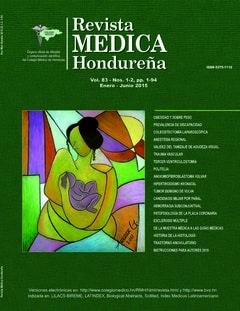Validez del tamizaje de agudeza visual realizado por maestros de escuelas primarias
Palabras clave:
Tamizaje, agudeza visual, niños, maestrosResumen
Marco conceptual: El manejo y detección de ametropías en la niñez es multidisciplinario. Los programas de tamizaje incluyen maestros, pediatras, oftalmólogos y optometristas, con el fin de corregir y prevenir la ambliopía. Objetivo: Evaluar la efectividad del tamizaje realizado por maestros que fueron capacitados en la toma de agudeza visual. Metodología: Se realizó estudio de concordancia en donde el universo lo constituyeron 33 maestros de las Escuelas primarias República de Nicaragua, Reino de los Países Bajos y República de Paraguay del sector público del municipio del Distrito Central de Honduras. El estudio se llevó a cabo en el año lectivo 2015 entre los meses de mayo a julio. Se evaluaron 840 estudiantes matriculados de primero a sexto grado. La medición de la agudeza visual se realizó utilizando la Cartilla Snellen, tomando como punto de corte mediciones menores a 20/30 en el mejor ojo. Los estudiantes con dicha agudeza visual fueron examinados por los médicos residentes cuya evaluación fue considerada el gold estándar del estudio para determinar la sensibilidad y especificidad de las mediciones realizadas por los maestros. Resultados: La sensibilidad y especificidad del tamizaje ejecutado por los maestros fue de 100% y 74% respectivamente. El resultado de índice de Kappa de Cohen fue de 0.65. Conclusiones: los resultados del presente estudio indican que el tamizaje de agudeza visual realizado por los maestros presenta validez aceptable para identificar casos positivos de disminución de agudeza visual y que es mejor elegir una prueba muy sensible si se prefiere obtener falsos positivos en lugar de falsos negativos.
Descargas
301




